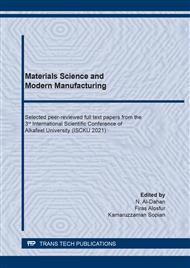[1]
Kandasamy R, Wang XQ, Mujumdar AS. Transient cooling of electronics using PCM-based heat sinks. J Appl Therm Eng 2008; 28:1047–57.
DOI: 10.1016/j.applthermaleng.2007.06.010
Google Scholar
[2]
S.C. Fok, W. Shen, F.L. Tan, Cooling of portable hand-held electronic devices using phase change materials in finned heat sinks, Int. J. Therm. Sci. 49 (2010) 109 e117.
DOI: 10.1016/j.ijthermalsci.2009.06.011
Google Scholar
[3]
Wang Hongfei et al., Experimental investigation on the thermal performance of a heat sink filled with porous metal fiber sintered felt/paraffin composite phase change material, Appl. Energy 176 (2016) 221–232.
DOI: 10.1016/j.apenergy.2016.05.050
Google Scholar
[4]
Hafiz Muhammad Ali, Adeel Arshad, Experimental investigation of n-eicosane based circular pin-fin heat sinks for passive cooling of electronic devices, Int. J. Heat Mass Transf. 112 (2017) 649–661.
DOI: 10.1016/j.ijheatmasstransfer.2017.05.004
Google Scholar
[5]
Adeel Arshad et al., Thermal performance of phase change material (PCM) based pin-finned heat sinks for electronics devices: effect of pin thickness and PCM volume fraction, Appl. Therm. Eng. 112 (2017) 143–155.
DOI: 10.1016/j.applthermaleng.2016.10.090
Google Scholar
[6]
S.C. Fok, W. Shen, F.L. Tan, Cooling of portable hand-held electronic devices using phase change materials in finned heat sinks, Int. J. Therm. Sci. 49 (1) (2010) 109–117.
DOI: 10.1016/j.ijthermalsci.2009.06.011
Google Scholar
[7]
Hu, Jinyan, et al. ,Effect of melting temperature and amount of the phase change material (PCM) on thermal performance of hybrid heat sinks. In: Electronic Packaging Technology (ICEPT), 2014 15th International Conference on. IEEE, (2014).
DOI: 10.1109/icept.2014.6922584
Google Scholar
[8]
Gharbi Salma, Souad Harmand, Sadok Ben Jabrallah, Experimental comparison between different configurations of PCM based heat sinks for cooling electronic components, Appl. Therm. Eng. 87 (2015) 454–462.
DOI: 10.1016/j.applthermaleng.2015.05.024
Google Scholar
[9]
Dong-Kwon Kim, Thermal optimization of plate-fin heat sinks with fins of variable thickness under natural convection, Int. J. Heat Mass Transfer 55 (4) (2012) 752–761.
DOI: 10.1016/j.ijheatmasstransfer.2011.10.034
Google Scholar
[10]
N.S. Bondareva, M.A. Sheremet, Conjugate heat transfer in the PCM-based heat storage system with finned copper profile: application in electronics cooling, Int. J. Heat Mass Transf. 124 (2018) 1275–1284.
DOI: 10.1016/j.ijheatmasstransfer.2018.04.040
Google Scholar
[11]
R. Kalbasi, M. Afrand, J. Alsarraf, M.-D. Tran, Studies on optimum fins number in PCM-based heat sinks, Energy 171 (2019) 1088e1099.
DOI: 10.1016/j.energy.2019.01.070
Google Scholar


